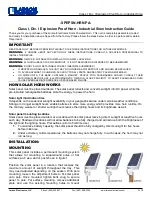
— 70 —
6F3A4768
3.4.5.2 Scan Transmission
This transmission system transmits data at specified intervals (at regular time).
There are inputs and outputs as drive equipment. Inputs are command input of the speed reference and the
sequence signal from PLC etc. Outputs are used for transmission of the actual value of speed and current, etc.
from drive equipment to control / surveillance apparatus of upper side, such as PLC.
DP Transmission Protocol (DP-V0)
This drive equipment corresponds to DP communication protocol (DP-V0) of PROFIBUS.
Number of Transmission Words
The number of send and receive transmission words which one station (drive equipment) treats are 6 words.
PROFIBUS Transmission Mode
The transmission mode of PROFIBUS has the mode 4 and the mode 5. The transmission mode is set up by
$TL_SELF_NO. The sending and receiving contents in the case of the transmission mode 4 are shown in
Fig.
3.4.14
.
PROFIBUS Master
PLC etc.
PROFIBUS slave
Drive equipment
Optional address defined by $SCAN_RCV01_AS
Optional address defined by $SCAN_RCV02_AS
Optional address defined by $SCAN_RCV03_AS
Optional address defined by $SCAN_RCV04_AS
Optional address defined by $SCAN_RCV05_AS
Optional address defined by $SCAN_RCV06_AS
PZD1
PZD2
PZD3
PZD4
PZD5
PZD6
Optional address defined by $SCAN_WR01_AS
Optional address defined by $SCAN_WR02_AS
Optional address defined by $SCAN_WR03_AS
Optional address defined by $SCAN_WR04_AS
Optional address defined by $SCAN_WR05_AS
Optional address defined by $SCAN_WR06_AS
PZD1
PZD2
PZD3
PZD4
PZD5
PZD6
ARND-8130
Fig. 3.4.14
PROFIBUS Transmission Mode 4
The sending and receiving contents in the case of the transmission mode 5 are shown in
Fig. 3.4.15
. As for the
first word, sending and receiving perform bit transmission inside a transmission board. The contents of transmission
of PROFIBUS master (PLC) are based on PROFIBUS Nutzerorganisation e.V. Profile for variable speed drives,
PROFIDRIVE Profile number: 3 Version: 2 Edition: September 1997.
Transmission data format
Data format of drive equipment is little endian. That is, as address in terms of bytes, upper byte of a word data
is in address m+1 and lower byte of word data is address m.
This arrangement of some PLCs is reverse. In this case, it is necessary to reverse upper/lower byte in PLC
application. Some master stations have this setting.
StockCheck.com
















































